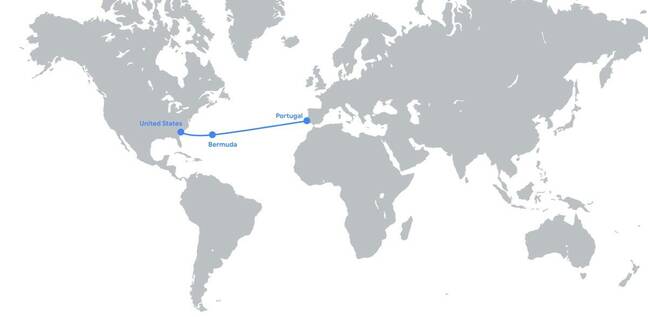Bermuda, your data, Google's gonna take your US data
Search giant's latest subsea cable will feed your YouTube addiction
Updated Google is building a new subsea cable, due to come online in 2026, that will connect South Carolina to Portugal with a layover in Bermuda.
The search giant says the cable, dubbed Nuvem — the Portuguese word for cloud — will add capacity, reduce latency, and improve the strength and route diversity of its transatlantic network.
Considering all the subsea cable breaks we've seen over the past few years, this seems as good a reason as any. However, for the British territory of Bermuda through which the cable passes on its way to Portugal and the rest of Europe, the data link holds special significance.
"The BDA has long advocated that Bermuda's centrality makes it an ideal landfall and interconnection point for submarine cables between the Americas, Europe, and Africa and we are so excited these efforts have borne fruit," David Hart, CEO of Bermuda's Business Development Agency (BDA) said in a statement.
Google claims Nuvem will "not only be the first cable to land under this robust environment, but the first to connect Bermuda to Europe."
Beyond any economic potential the subsea route could unlock for the territory, not much is known about the cable or its capabilities. The Register asked Google for more information on the cable itself, but the company was unable to answer specific questions regarding the length, capacity, or cost of the pipe laying.
A Google spokesperson did confirm that the company planned "to work with partners to make route capacity available to a wide range of organizations." So, Nuvem won't just be shuttling YouTube videos and GDocs around when it's completed.

Google's Nuvem subsea cable will connect the US to Portugal with a stop in Bermuda along the way. - Click to enlarge
Given the relatively straightforward path planned for Nuvem, we can estimate the cable will span about 3,500 nautical miles. That's about 294,911 Brontosauruses for long-time El Reg readers. However, estimating the bandwidth capacity of the cable is a far trickier proposition as it depends on a number of factors, including the number of fiber strands, optics, repeaters, and other equipment used along the route.
- Alphabet, Bharti Airtel to bridge India's digital divide with frickin' laser beams
- China sought control of submarine cables to spy, says Micronesia
- Biden to bolster boondocks broadband with a billion bonus bucks (barely)
- What's really up with data disconnects in the deep blue sea?
Google's Duvant subsea cable, which was completed in 2021 and connects Virginia Beach to the French Atlantic coast, does offer some clues. That cable used 12 fiber pairs and space division multiplexing (SDM) to achieve 250Tb/s of capacity.
With Nuvem due to come online about five years later, we suspect Google will be using newer optics and potentially a larger bundle of fibers to achieve even higher capacities.
Nuvem is only Google's latest subsea. The company has invested heavily to build out its global network backbone over the past few years. Two of the more recent examples include the Firmina and Echo cables, both of which were announced in 2021. The former aims to connect the US to Argentina, Brazil, and Uruguay. The latter, meanwhile, will connect California to Singapore and Indonesia with a stop over in Guam. ®
Updated to add
We asked our contacts at Infinera, which produces optics used in a variety of applications, for their best guess on data capacity. Using leading edge optics, the networking biz said each fiber pair could support between 25-30Tb/s. Based on this the company estimates Nuven could support 300-360Tb/s of capacity for a cable with 12 fiber pairs or 400-480Tb/s for one with 16 pairs.
 Biting the hand that feeds IT
Biting the hand that feeds IT